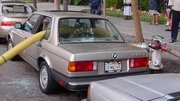Fire hydrant
|
|
A fire hydrant (or colloquially in the US, fire plug) is a source of water provided by most metropolitan communities to enable firefighters to tap into the municipal water supply to assist in extinguishing a fire. To prevent casual use or misuse, the hydrant requires special tools to be opened, usually a large wrench with a pentagon-shaped socket. Due to their size and construction, a large amount of force is required to uncap the hydrant and open the valve. Vandals, or simply those seeking to play in the water sometimes break them open, often using force, providing residents (especially children) a place to play in the resulting water. The fire hydrant was invented by Birdsill Holly in around 1869.
Some US communities provide sprinkler heads to enable residents to use the hydrants to cool off during hot weather. Due to the presence of standing water inside the hydrant for weeks or months at a time, it is necessary to drain them on occasion to prevent bacteria from seeping back into the drinking water system serving the hydrant.
| Contents |
Operation
A hose is attached to the hydrant, then the valve is opened to provide a powerful source of water, 50 lb/in² (350 kPa) in some areas (possibly more in others), depending on various factors including the size and location of the attached water main. This hose can be further attached to a fire engine, which can then use a powerful pump to boost the pressure and possibly split it into multiple streams. Care should be taken not to open or close a fire hydrant too quickly, as this can create a water hammer which can damage nearby pipes and equipment.
Most fire hydrant valves are not designed to throttle the water flow, they are designed to be operated full-on or full-off. Attempting to throttle the flow with the hydrant valve can cause damage to some hydrant designs. A hose with a closed nozzle valve, or fire truck connection, or closed gate valve is always attached to the hydrant prior to opening the hydrant's main valve.
In most US areas, contractors who need temporary water may purchase permits to use hydrants. The permit will generally require a meter, a gate valve and sometimes a clapper valve (if not designed into the hydrant already) to prevent backflow into the hydrant. Additionally, residents who wish to use the hydrant to fill their in-ground swimming pool are commonly permitted to do so provided they pay for the water and agree to allow firefighters to draft from their pool in the case of an emergency.
The high water pressure inside the hose causes it to be very heavy, stiff, and unable to make a tight turn while pressurized. When a fire hydrant is unobstructed, this is not a problem, as there is enough room to adequately position the hose. It is illegal in many jurisdictions (but legal in others such as the UK), to park a car in front of or within a certain distance of a fire hydrant. The distances are commonly 10-15 ft, or 3-5 m. Unfortunately, this is commonly ignored (especially in cities where available street parking is scarce), and causes a headache for firefighters who need to connect to the hydrant. In the movie Backdraft, a firefighter faced with this problem smashes the windows in the car and passes the firehose through the car to the fire hydrant. In reality you probably would not want to put a firehose through a broken window on purpose.
Construction
In areas subject to freezing temperatures, only a portion of the hydrant is above ground. The valve is located below the frost line and connected via a riser to the above-ground portion. A valve rod extends from the valve itself up through a seal at the top of the hydrant, where it can be operated with the proper wrench.
In warm areas, inexpensive hydrants are used with one or more valves in the above-ground portion. Unlike cold-weather hydrants, it is possible to turn the water supply on and off to each port.
Due to their constant presence and utilitarian nature, some cities and towns allow fire hydrants to be painted in various colors and/or as whimsical characters. The most common colors are red and yellow. In other places, such as in Ottawa, hydrant colors communicate different messages to firefighters; for example, if the inside of the hydrant is corroded so much that the interior diameter is too narrow for good pressure, it will be painted in a specific scheme to indicate to firefighters to move on to the next one. In many localities, a white or purple top indicates that the hydrant provides non-potable water.
Fire hydrant signage
Fire_Hydrant_414x762.jpg
In the UK, hydrants are located in the ground. Yellow "H" hydrant signs indicate the location of the hydrants, and are similar to the blue signs in Finland. Mounted on a small post or nearby wall etc, the two numbers indicate the size of the water main in mm (top number) and the distance in metres from the sign (lower number). Older signs may use Imperial units.
In areas of the U.S. without winter snow cover, blue reflectors embedded in the street are used to allow rapid identification of hydrants at night. In areas with snow cover, tall signs or flags are used so that hydrants can be located even if covered with snow.
See also: fire extinguisher, sprinkler, arson.
External links
- FireHydrant.Org (http://www.firehydrant.org/pictures/)



